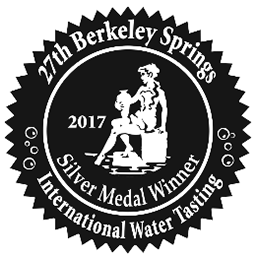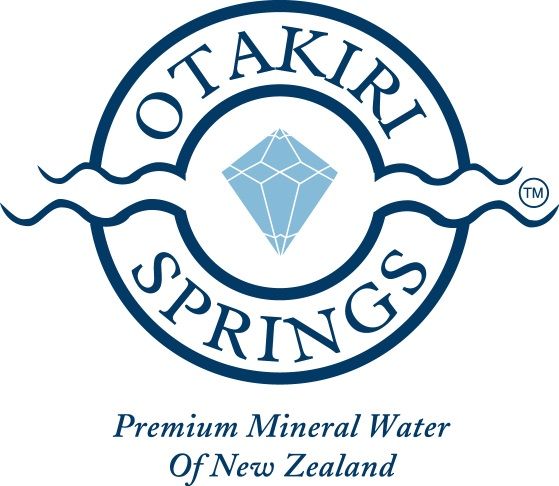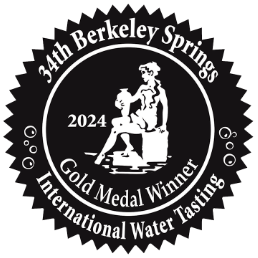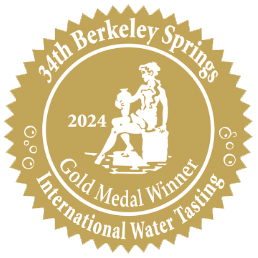THE SOURCE
There is something special about the place our water springs from. Deep underground, a layer of porous rock transports and purifies rain that fell on densely forested hills 50 years ago. This ingenious remarkable natural filtration system is known as Otakiri Aquifer. Decades-old rainwater travels through hidden fractures beneath the ground and into our underground water channel or aquifer, which continually confines and pressurises the precious liquid until it emerges cleansed of all impurities The water also absorbs essential characteristics from its subterranean environment. It’s this unique blend of added minerals that imbues Otakiri water with its essence.
In fact, its composition is so finely, perfectly balanced it outshines bore water samples taken from just a few hundred metres away. Otakiri is the embodiment of natures perfection.
A TASTE OF 932
We source draw our water at a location hydrologists have designated “932”. It’s artesian, which means it travels to the surface under its own pressure; in this case an upward journey of more than 200 metres. And we bottle at its source. This means Otakiri water is only exposed to the air at the moment it goes into the bottle, so its purity is never compromised. The second time it meets the air is when you open your own bottle, to taste water purified by nature.literally “a la natural”.
THE WATER
We claim One sip of Otakiri confirms its superiority. Otakiri Aquifer delivers naturally clean, healthy water imbued with the dissolved minerals that provide its distinct character and taste. And we can prove it. Our water’s exceptionally high quality is scientifically measurable. It has been independently analysed by MWH Laboratories on behalf of the American Food and Drug Administration. Don’t take our word for it though. See for yourself, the exceptional characteristics of Otakiri Source 932 . . .
Total Dissolved Solids
Sometimes, water is compared to wine. The quantity of minerals dissolved in the water is expressed as total dissolved solids (TDS) and is measured in milligrams (a thousandth of a gram) per litre of water.
Low TDS waters have been compared to white wines with a light, clean, neutral taste.
High TDS waters have a heavier taste and are the red wine equivalent.
Low
Medium
High
50-250mg/l ..........Otakiri Source 932 130mg/l
250 – 500mg/l
500 – 1,500mg/l

Purity
By definition, no mineral water is comprised solely of H2O (hydrogen and oxygen). However, it’s important that any additional minerals are desirable and healthy. Nitrate levels are a good measure of the purity of a water source as they are linked to human activity levels. In its natural state, water has less than 1mg/l of nitrates. Anything above that indicates some outside influence as nitrates are easily dissolved in water and carried into water sources.
Superior
Very Good
Good
Acceptable
Potable
0 -1mg/l ............. Otakiri Source 932 0.3mg/l
1 – 4mg/l
4 – 7mg/l
7 – 10mg/l
10 – 50mg/l
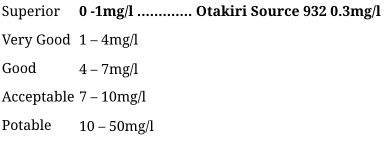
Carbonation
The amount of sparkle in your mineral water plays a large part in its taste and your experience. The space between the bubbles and their size affect the sensation and after-taste.
High TDS waters often have large bubbles.
Lightly carbonated, low TDS waters such as Otakiri are noticeable for their subtle mouth feel.
People who normally wouldn’t like “fizzy water” often love light, sparkling water. It provides texture but doesn’t overpower the food match and has a light, cleansing appeal on its own.
Acidity (pH)
Acidity levels are measured using pH. A highly acidic liquid would have a pH level of 1, while an extremely alkaline liquid would have a pH of 14. In the middle, a pH level of between 7.0 and 7.5 indicates neutral taste and is sometimes described as “sweet” because it is neither sour (acidic) or bitter (alkaline). Otakiri water tests in the range of 6.8 to 7.2, or neutral. So any “taste” comes is driven by its mineral component levels, rather than a sour or bitter pH.
1
7
14
Acidic (Sour)
Neutral (Sweet) .........Otakiri Source 932 (6.8 - 7.2)
Alkaline (Bitter)

Age
Much is made of the age of water when it is bottled. But this is only part of the story. True, time allows water to dissolve minerals and achieve tasteful characteristics. However, this process is either hastened or slowed by the solubility of the geological material the water passes through.
In the case of Otakiri, 50 years is plenty of time to produce perfection.
Silica 73mg/l Bicarbonate 40mg/l Sulphate 3.1mg/l Sodium 12mg/l Potassium 3.5mg/l Calcium 3.1mg/ Magnesium 1.8mg/l
